Understanding Candlestick Stocks for Traders
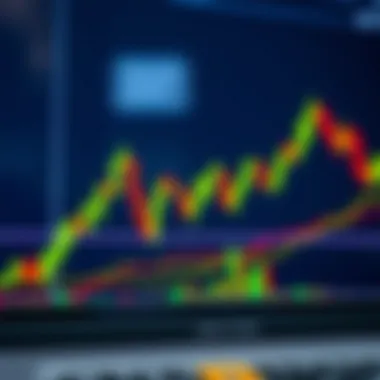
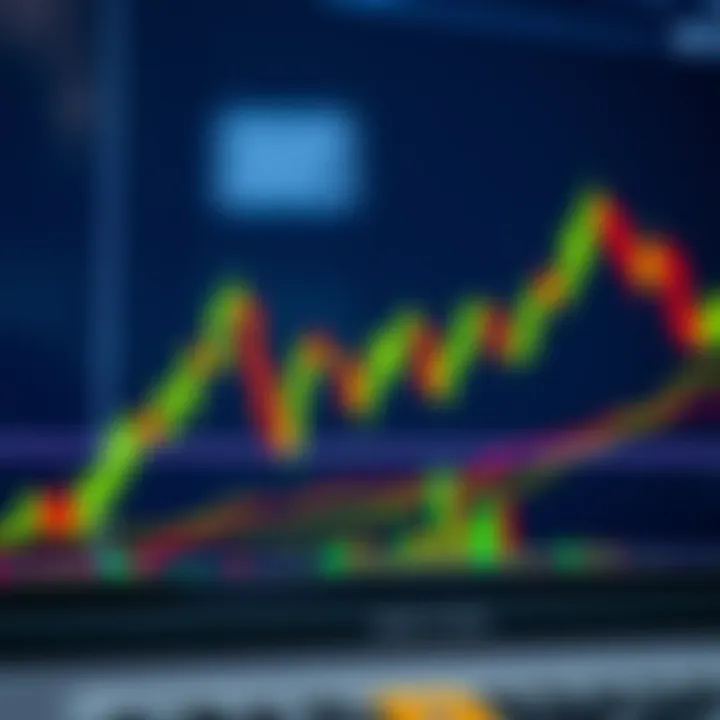
Intro
The world of trading can feel like a maze, especially for those just starting out. As market dynamics constantly shift, understanding various tools and strategies becomes crucial for making informed decisions. One such tool is candlestick charting, a visual aid that has stood the test of time in the trading arena. Candlestick patterns not only reflect market sentiment but also allow traders to glimpse into potential price movements.
Candlestick charts date back to the 18th century in Japan, initially used to track rice prices. Today, these charts transcend commodities, finding their place within stocks, forex, and cryptocurrency markets. As we delve into the intricacies of candle stocks, we’ll uncover how these patterns can influence trading strategies. Whether you are a seasoned investor or a beginner, grasping the essence of candlestick patterns can turn the tide in your trading endeavors.
By the end of this article, we aim to cover:
- Key elements of candlestick patterns and their interpretations.
- The psychological factors influencing traders’ actions.
- Historical development and significance of candlestick charting.
Equipping yourself with these insights will furnish you with a stronger foundation in market analysis. Let's embark on this enlightening journey into the realm of candle stocks!
Understanding Candlestick Charts
Candlestick charts are a cornerstone in the toolkit of investors and traders. Understanding them is essential because they encapsulate price movements over time, offering insights that go beyond mere numbers. The patterns formed by candlesticks provide a visual representation of market behavior, reflecting the collective sentiment of traders and their decisions. Their ability to distill complex market data into a format that's accessible makes them indispensable for anyone looking to navigate the tumultuous waters of trading and investment.
Preface to Candlestick Charts
At their core, candlestick charts serve to visually illustrate price fluctuations within a specific time frame. Each candlestick represents a period of trading—whether that be a minute, hour, day, or longer. This format allows traders to discern the relationship between the open and close prices, as well as the high and low for a given time, giving birth to patterns that can predict future price movements. By focusing on the shadows and bodies of these candlesticks, traders get essential signals that guide their decision-making process.
Historical Background
The art of using candlestick charts dates back to the 18th century, originating in Japan. The creator, Homma Munehisa, a rice trader, developed this method to track rice prices—a precursor to modern trading practices. Over time, this technique migrated to the West, primarily due to the work of Charles Dow and others who recognized the powerful indicators embedded within these charts. Today, the method remains deeply woven into the fabric of trading strategies, evolving while still preserving its historical roots.
Components of a Candlestick
Body
The body of a candlestick is crucial as it visually encapsulates the price movement within a specified period. It shows the difference between the opening and closing prices, where a solid body indicates a closed price lower than the opening price (a bearish move), and a hollow body reveals a closing price that's higher than the opening price (a bullish move). This characteristic is popular because it quickly conveys strength or weakness in market sentiment. A notable attribute of the body is its size; a larger body suggests strong buyer or seller activity, while a smaller body indicates indecision. Thus, traders frequently rely on the body to understand market pressure.
Wick
The wick (or shadow) adds a layer of depth to candlestick analysis. It indicates the highest and lowest prices traded during that period, showing traders the volatility of price movement. An extended wick can highlight potential overbought or oversold conditions. It's beneficial because it offers clues about reversals and continuations in price trends. One unique feature is that long wicks combined with small bodies often signal market indecision, potentially leading to reversals. However, one must tread carefully, as wicks can sometimes lead to false assumptions if viewed in isolation.
Open and Close Prices
Lastly, the open and close prices form the fundamental components of each candlestick. The opening price marks the start of trading for that period, while the closing price reflects the final trade. Their relationship is central to interpreting market currents. The distinction between these two prices can signal changes in market sentiment. For instance, if the close is near the high, it shows potential bullish sentiment, hinting that buyers were in control. Conversely, a close near the low signals bearish sentiment. This dynamic makes the open and close prices vital for understanding movements and trends in the trading landscape.
Significance of Candle Stocks
Candlestick analysis stands tall in the vast landscape of trading strategies. It offers insights into market sentiment and price movements, acting as a visual storyboard for traders. The significance of this method cannot be overstated as it serves multiple purposes in trading and investment decision-making. At its core, the candlestick chart encapsulates a wealth of information in a simple format, making it an indispensable tool for both aspiring and seasoned traders.
The intricate designs of candlestick patterns provide traders with immediate visual cues about potential price movements. Beginners might find themselves grappling with complex numbers and indicators, but the straightforward approach of candlestick patterns makes it easier to grasp market dynamics. Knowing when to buy or sell is vital, and these patterns can act like traffic lights—in green you go, in red you stop.
- Enhanced Market Understanding: Candlestick stocks pave the way for a deeper comprehension of market psychology. They reveal how traders react to specific events and price changes, thus helping in forecasting future trends based on historical behavior.
- Decision-Making Tool: Traders who rely on candlestick patterns often claim they feel more empowered when making decisions. These patterns help in determining potential entry and exit points. It's like having a compass when sailing in rough waters; it guides you in the right direction.
- Versatility Across Markets: The beauty of candlestick analysis is its applicability across various trading markets—from equities to Forex and beyond. Regardless of the asset class, traders can utilize candlesticks to identify prevailing trends, making it a universal language in trading.
"The patterns formed by candle stocks provide clarity in the chaotic world of trading, revealing the sentiments that underpin market movements."
Understanding the significance of candle stocks lends traders an edge, allowing them to operate with greater confidence in uncertain environments. The focus on market psychology and pattern recognition ensures that they are not merely guessing but rather informed players in an intricate game.
Market Psychology
Market psychology is the heartbeat of trading; it significantly influences price movements. At its essence, market psychology pertains to the collective feelings, attitudes, and behaviors of traders as they react to news, market trends, and other stimuli. In this swirling ocean of emotions, candlestick patterns serve as touchstones. They represent the dazzled frenzy of panic, greed, and, at times, quiet reflection.
When traders view a candlestick chart, they’re not just seeing green and red bars; they’re witnessing stories. Each candle reflects a set of emotional responses to market conditions during a specific timeframe. For instance, a long green candle may indicate strong bullish sentiment, suggesting that buyers are in control. Conversely, a long red candle could suggest overwhelming bearish pressure.
Influencing Factors
- Market News: Major headlines can shift sentiment overnight. Traders might react aggressively to unexpected economic reports, showing in the candlestick formations.
- Fear and Greed: These two primal forces significantly alter prices. When traders feel overly confident, in a bull market, they might overlook indicators, leading to the formation of unrealistic patterns like the “Shooting Star.” It’s important to strike a balance.
- Herd Behavior: Many traders fall into the trap of following the crowd. This phenomenon often causes rapid price changes, easily observable through the patterns on a candlestick chart.
Market psychology is not just a whispered notion; it’s the very essence that shapes charts and determines price action. Recognizing these emotions through candlestick patterns allows traders to make more emotionally intelligent decisions and navigate market volatility.
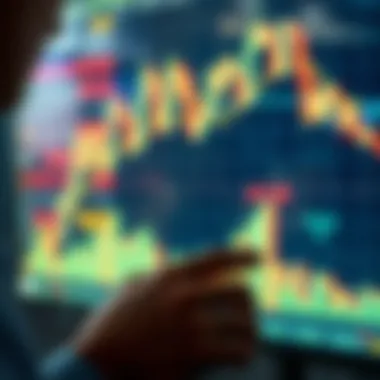

Predictive Power
One of the most compelling reasons traders turn to candlestick patterns is their predictive power. The ability to foresee potential price movements based on historical data provides an edge that many traders crave. Understanding this predictive capability is akin to reading a weather forecast before deciding to step outside. It informs and mitigates risks, paving the way for more informed trading decisions.
Notable Features of Predictive Power
- Historical Significance: Candlestick patterns are not merely random occurrences. They are steeped in historical trading behavior, allowing traders to spot patterns that have led to certain outcomes in the past. This historical grounding is what makes these patterns more than just guesswork.
- Combination Strategies: Many traders leverage candlestick patterns along with other technical indicators to confirm signals. For instance, if a bullish engulfing pattern coincides with a moving average crossover, it strengthens the likelihood of an upward price movement.
- Timeframe Adaptability: Whether you are day trading or analyzing long-term trends, the predictive nature of candlestick patterns transcends timeframes. This flexibility appeals to various trading styles, making it easier to adapt strategies to one’s preference.
Types of Candlestick Patterns
Understanding the various types of candlestick patterns is crucial for anyone venturing into the world of trading, especially in technical analysis. Each pattern tells a story about market sentiments, cyclist underlying feelings of traders, and potential future price actions. Familiarity with these patterns not only enhances one’s analytical skills but also equips traders and investors to make educated decisions based on past behaviors. Recognizing these patterns can often give a leg-up in predicting market shifts, leading to more effective trading strategies.
Single Candlestick Patterns
The Hammer
The Hammer is a potent single candlestick pattern that forms when the security trades significantly lower than its opening price but rallies to close near the opening price. Visually, it resembles a hammer due to its small body at the top with a long lower wick. The presence of this pattern suggests a possible bullish reversal. Investors often see The Hammer as a sign of buying pressure, hinting that even though sellers pushed prices down, buyers stepped in to regain control. One notable aspect is that the lower shadow should be at least twice the length of the body to confirm its significance. It's a popular choice among traders because it can signal entry points in a downtrend.
However, traders should exercise caution since The Hammer alone does not guarantee a price reversal; it should preferably be backed up by supportive volume and follow-through buying in subsequent sessions.
The Inverted Hammer
The Inverted Hammer is visually similar to The Hammer but appears after a price decline. It also has a small body at the bottom with a long upper wick, suggesting that buyers attempted to push the price higher but sellers eventually stepped in. This pattern indicates potential bullish reversal, as it reflects a fight between the buyers and sellers. Its unique feature lies in the fact that it could appear in a downward trend and signal that upward momentum might be on the horizon.
This pattern, while promising, can sometimes lead to false breakouts. It's critical for traders to wait for confirmation, preferably through subsequent candlesticks closing above the Inverted Hammer's body, before staking any significant decisions.
The Doji
The Doji stands out among candlestick patterns due to its distinct appearance of having nearly equal open and close prices, resulting in a very short body, and it can indicate market indecision. It can form in various market situations and can signify bottoms and tops depending on its position within an established trend. What makes The Doji special is that it reflects a stalemate between buyers and sellers, indicating potential market reversal.
Traders often value The Doji for its ability to highlight potential turning points, but interpreting it needs care. An isolated Doji carries less weight than one that forms after a strong trend and should ideally be confirmed by surrounding candles for maximum reliability.
Multiple Candlestick Patterns
Engulfing Patterns
Engulfing Patterns represent the consolidation of momentum and signify potential reversals. They consist of two candles, where the second candle completely engulfs the first candle's body. A Bullish Engulfing occurs after a downtrend and suggests that buyers have taken control, while a Bearish Engulfing appears after an uptrend, indicating a shift in power to sellers. The striking feature that makes these patterns so effective is their ability to convey strong market sentiment shifts in a concise manner. In this article, their predictive power makes them a staple for traders seeking to align with market trends.
Harami Patterns
Harami Patterns are characterized by a small candle that is contained within the body of a previous large candle. This pattern is a great indicator of potential reversals as it indicates indecision in the market. When traders see a Bullish Harami (downward trend followed by a small bullish candle), it leads to a possibility of price increase. Conversely, a Bearish Harami suggests a possible downturn. They are very beneficial in complex setups, but discretion is required as not all Harami patterns lead to reversals, necessitating a careful analysis of other indicators and market contexts.
Morning Star and Evening Star
The Morning Star and Evening Star patterns are three-candle formations that signal market reversals. The Morning Star begins with a bearish candle, followed by a smaller candle (indicating pause), and concludes with a bullish candle. It symbolizes a bullish reversal and suggests a shift in momentum after a downward trend. Conversely, the Evening Star follows the same structure but appears after an uptrend, indicating potential bearish reversal. These patterns are advantageous because they combine the strength of multiple candles to confirm the change in market sentiment, allowing traders to identify opportunities for strategic entry or exit.
Key Point: Recognizing candlestick patterns can be entertaining and an insightful method for traders when assessing potential market movements.
For more insight on candlestick analysis and trading strategies, visit resources like: Investopedia and TradingView.
Interpreting Candlestick Patterns
Interpreting candlestick patterns is a crucial skill in the world of trading and investing. Understanding how to read these patterns can provide investors with valuable insights into market sentiment and potential price movements. The patterns derived from candlestick charts are more than mere symbols; they are indicators of buyers and sellers in action. Recognizing the psychology behind these patterns can enhance one’s trading strategy significantly.
Analyzing Trends
To effectively analyze trends using candlestick patterns, one should first comprehend the foundational principles governing price movements. Usually, trends are categorized into three types: upward, downward, and sideways. Charts reveal not only the direction of these trends but also the strength behind them.
Traders often look at candlestick formations to gauge whether a trend is continuing or reversing. Key concepts include:
- Higher highs and higher lows indicate a bullish trend.
- Lower highs and lower lows suggest a bearish trend.
- Flat tops or bottoms can signal consolidation or indecision in the market.
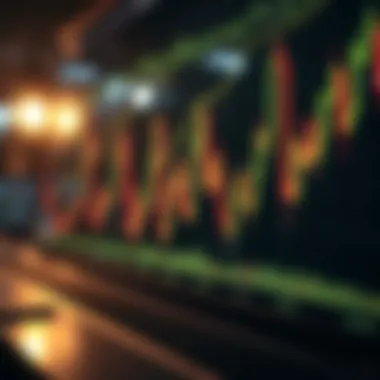

By observing how candlesticks stack up against previous formations, traders can deduce strength or weakness in the prevailing direction. For instance, if a series of bullish candlesticks forms after a period of downtrend, it may suggest a potential reversal, often identified by patterns like the Bullish Engulfing.
Moreover, volume plays a significant role in this analysis. If a bullish candlestick appears with high volume, it indicates that not just the candle but the trend is robust and likely to continue. Conversely, if the bullish candle appears with low volume, traders might suspect a weakening trend, warranting caution.
Using Patterns in Trading Strategies
Candlestick patterns can be effectively integrated into trading strategies, enabling traders to make calculated and timely moves. Here’s how to leverage these patterns:
- Entry Points: Patterns such as the Hammer or the Morning Star can signify ideal entry points. These formations suggest that the bears have lost control and that a bullish phase may emerge.
- Exit Points: Candlestick formations might cater to exit strategies as well. A Shooting Star or a Dark Cloud Cover after a lengthy bullish rally might signal traders to consider taking profits or instituting stop-loss orders to mitigate risks.
- Risk Management: Using candlestick patterns alongside support and resistance levels can enhance risk management. For example, if a bullish pattern appears near a strong support level, it may reinforce the decision to set a trade. Conversely, recognizing a bearish pattern at resistance can provide insight for exiting a position.
It is vital to note that while candlestick patterns provide excellent insights, relying solely on them can be misleading. Traders should combine candlestick analysis with other tools such as moving averages or RSI (Relative Strength Index) to confirm trends before making decisions.
"Candlesticks can light the path through the fog of uncertainty in financial markets, illuminating where opportunities lie and where caution is needed."
Closure
The interpretation of candlestick patterns forms a bridge to a deeper understanding of market rhythms. Investors who can read these patterns skillfully become adept at deciphering market behavior. Thus, by embracing this analytical approach, traders can enhance their ability to predict market shifts, leading to more informed investment choices. As the saying goes, knowledge is power, and in the domain of trading, this rings particularly true.
Limitations of Candlestick Analysis
When it comes to evaluating candlestick patterns, it's easy to get wrapped up in their apparent precision and elegance. However, it's crucial to acknowledge that relying solely on candlestick analysis can lead traders down a precarious path. Understanding the limitations can not only refine your trading approach but also enhance your decision-making skills.
False Signals
Candlestick patterns are far from foolproof. One of the most significant issues traders face is the occurrence of false signals. For example, a bullish engulfing pattern might look ideal on a chart, tempting traders to jump in, only to find that it reverses swiftly. This sort of phenomenon can be incredibly frustrating and financially damaging. To compound the problem, the same pattern may yield different outcomes in varying market conditions.
Not all candlestick formations carry the same weight, and some might just be noise in an otherwise chaotic market. Traders should remain skeptical of any single candlestick, especially in volatile markets where price movements can be erratic. It’s a bit like judging a book by its cover; sometimes, the inside tells a different story than the title might suggest.
Need for Complementary Analysis
Relying only on candlestick patterns without considering additional analyses is akin to sailing a ship without a compass. While candlestick charts can provide valuable insights, they do not exist in isolation. Incorporating other analytical tools such as volume analysis, moving averages, or even fundamental analysis can yield a more comprehensive view of market conditions.
For instance, if a trader spots a reversal pattern but ignores the trading volume, they might miss critical information about the strength of the signal. High volume during a reversal pattern typically reinforces its reliability, whereas low volume might render it suspect. The best traders know that being thorough is non-negotiable.
In summary, the limitations of candlestick analysis cannot be dismissed. While they serve as useful tools for interpreting market behavior, they should never be the only frame of reference. Being aware of the tendency for false signals and the importance of complementary analysis can empower traders, making their strategies more robust and informed. As the markets continue to evolve, so should our methods of analysis.
Practical Applications of Candlestick Analysis
Candlestick analysis isn’t just theory; it’s an essential part of the trader’s toolkit. The practical applications of this method can make or break your trading strategy. Understanding candlesticks allows traders to read market sentiment and make real-time decisions. This section covers how traders can use candlestick patterns effectively in their trading.
Day Trading Techniques
Day trading is a fast-paced environment where decisions are made in mere moments. Candlestick charts provide the clarity needed to make these quick decisions. Traders often look for specific patterns that signal when to buy or sell within a trading session.
- Use of Short-Term Patterns: Day traders commonly utilize two main candlestick patterns: the Doji and the Hammer. A Doji indicates indecision in the market, which might signal that a price move is imminent. A Hammer, on the other hand, suggests a potential reversal after a downtrend, presenting an opportunity for profit.
- Volume Confirmation: High volume accompanying a candlestick formation can validate the signal it provides. For instance, when a bullish engulfing pattern forms with increased trading volume, it suggests that buyers are stepping in, enhancing the likelihood of a bullish trend.
- Setting Exit Points: Traders can use the length of the candle’s tail to set stop-loss orders. A longer tail in the opposite direction of a trader’s position indicates where the price has pushed back, and a stop-loss can be set just beyond this point to avoid unnecessary losses.
"Success in day trading doesn’t solely come from recognizing the pattern, but from understanding the context—market behavior behind the candlesticks can tell you a lot."
Swing Trading Strategies
Swing trading typically involves holding positions for several days to capitalize on expected upward or downward market shifts. Candlestick analysis plays a crucial role in determining optimal entry and exit points in such scenarios.
- Identifying Trends: Swing traders benefit significantly from identifying the start of a trend using candlestick patterns. For example, the Morning Star pattern can signal a bullish trend reversal, indicating a good time to enter a trade.
- Combining with Moving Averages: Many swing traders utilize moving averages alongside candlestick patterns. The crossover of a short-term moving average over a long-term moving average can add further validation to a bullish or bearish signal seen in candlestick patterns.
- Targeting Profit Levels: When a trader identifies a strong candlestick pattern, measuring the length of the pattern can help in setting realistic profit targets. For instance, if a strong bullish candle forms, traders can set a target based on the preceding price action or Fibonacci retracement levels.
Using candlestick analysis, both day traders and swing traders can craft a more informed trading strategy. Recognizing how these patterns fit within the broader market context can lead to better decisions and ultimately, enhanced profitability.
Candlesticks in Different Markets
Candlestick charts are not limited to a single trading arena; they hold significant value across various market segments. Whether you are dealing in equities, forex, or cryptocurrencies, understanding how candlestick patterns function within these frameworks can yield you actionable insights. This understanding allows traders to adapt their strategies accordingly—picking the right patterns for the right markets can be the difference between profit and loss. It becomes clear that mastering these charts can provide a more nuanced picture of market sentiment and logic that drives price movement.
Equities
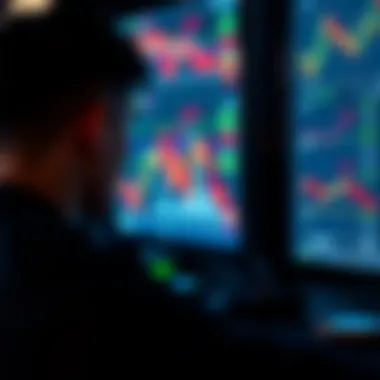

In the equities market, candlestick patterns often unveil the hidden rhythms of stock price movements, aiding in the identification of trends and reversals. Stocks can exhibit a high degree of volatility, especially around earnings announcements or economic reports. Traders often look towards single candlestick formations such as the Doji or Hammer to discern market indecision or potential reversals. Patterns like Engulfing or Harami can indicate strong buying or selling pressure, offering timely signals for possible entry or exit points.
Forex
The forex market dances to its own beat, often influenced by a myriad of global economic factors and geopolitical events. Candlestick charts, in this context, become an essential tool for traders looking to navigate this complex landscape. Currency pairs can show rapid shifts in value, and patterns may emerge more frequently than in equities. For instance, a Morning Star pattern might symbolize a bullish reversal after a downtrend, while the Evening Star can signal the opposite. These patterns help traders to gauge market sentiment on a minute-by-minute basis, as forex often operates on shorter timeframes compared to long-term equity strategies.
Cryptocurrencies
Bitcoin, Ethereum, and a plethora of altcoins are mapped through candlestick charts, giving traders insight into this highly volatile market. Cryptocurrencies can swing wildly within a short period, which makes candlestick analysis not just useful, but essential for risk management. Specific patterns, such as the Bullish or Bearish Engulfing candles, can indicate strong buying or selling opportunities in mere hours, if not minutes. This rapid pace demands that traders stay alert and informed. An investor betting on the volatility of cryptos will find that integrating candlestick patterns into their toolkit helps them stay ahead of the game in such an unpredictable market.
Understanding the application of candlesticks in different markets can be viewed as the ability to read the emotional pulse of trading participants.
In summary, realizing how candlestick charts apply in varied market types arm yourself with crucial analytical capabilities. The skill set you build around candlestick patterns can refine your trading strategies, enabling you to thrive in the sometimes tumultuous waters of trading.
Tools and Resources for Candlestick Analysis
When navigating the intricate world of candlestick analysis, having the right tools and resources can make all the difference. This section aims to illuminate the essential instruments and educational materials available to traders and investors to enhance their understanding and application of candlestick patterns.
Charting Software
Charting software is a fundamental resource in the toolkit of any trader or investor keen on candlestick analysis. These platforms allow users to visualize price movements over time, revealing trends and patterns that are critical for making informed decisions. With various options available, it’s vital to choose one that aligns with your trading strategy and level of expertise.
Some popular software solutions include TradingView, which offers customizable charts and a community of traders sharing insights, and MetaTrader, known for its advanced trading features and automated capabilities. Charting software typically includes:
- Real-time data feeds: Access to current market prices is crucial for timely decision-making.
- Customizable chart types: Beyond candlesticks, you might want to use line charts or bar charts depending on your analysis needs.
- Indicator overlays: These can help you to identify support and resistance levels, momentum, and more, integrating seamlessly with candlestick patterns.
- Backtesting tools: A feature that allows traders to apply their strategies to historical data, testing efficacy before implementing them in live markets.
Investing time in learning how to use charting software effectively can significantly alter your trading outcomes.
Educational Resources
Understanding candlestick patterns is not just about recognizing shapes; it involves grasping the market psychology that drives these movements. For that reason, educational resources are paramount. Thankfully, a plethora of materials exists to nurture both novice and seasoned investors.
- Books: Titles like "Japanese Candlestick Charting Techniques" by Steve Nison provide in-depth insights into the methodology and psychology behind candlestick formations.
- Online Courses: Websites like Coursera and Udemy offer structured learning paths that cover everything from the basics of candlestick analysis to more advanced strategies, often featuring interactive elements and real-life examples.
- Webinars and Workshops: Many trading platforms and financial institutions host live sessions on candlestick analysis. These are valuable for asking questions and engaging with experts in real-time.
"Knowledge is power, but it needs the right tools to be effective."
- Forums and Online Communities: Platforms like Reddit and the community sections of trading websites can be treasure troves of practical advice, tips, and feedback from traders with firsthand experience.
- Newsletters: Subscribing to financial newsletters can help you stay updated on market trends and tips related to candlestick analysis, meaning you’ll always have fresh insights at your disposal.
Future of Candlestick Analysis
The world of trading is constantly evolving, and with it, the tools and techniques that traders use. As we peer into the horizon, the future of candlestick analysis appears promising, intersecting with cutting-edge technologies and the growing capacity for data analytics. Embracing these advancements will not only enhance traditional charting methods but also provide fresh insights into market movements. This section delves into some pivotal elements highlighting the significance of the future of candlestick analysis, encompassing technological aspects and the integration of artificial intelligence.
Technological Advancements
Technology has undeniably transformed how traders analyze the markets, and candlestick charts are no exception. Today, traders have at their fingertips a myriad of sophisticated charting software and mobile applications that provide real-time data, enabling instant reaction to market changes.
As the speed of data continues to accelerate, tools like cloud computing and big data analytics will further refine candlestick analysis. Traders could leverage high-frequency trading strategies which rely on minute-by-minute, even second-by-second fluctuations in price. Moreover, as 5G technology becomes widespread, faster internet speeds will allow for sharper, more precise trading strategies utilizing candlestick patterns.
Some noteworthy advancements to keep an eye on include:
- Enhanced Visualization Tools: Charting platforms are adopting augmented reality features that allow traders to manipulate candlestick charts in a three-dimensional space.
- Predictive Analytics: Utilizing historical data to predict future movements will become more reliable with advancements in computing power.
- User-Friendly Interfaces: As platforms focus on the user experience, even novice traders could interpret complex candlestick patterns with intuitive designs.
These advancements provide the opportunity to adopt a more agile and responsive trading posture.
Integration with AI and Machine Learning
The integration of artificial intelligence (AI) and machine learning (ML) into candlestick analysis is perhaps one of the most exciting developments on the horizon. AI can process vast amounts of data far more efficiently than human traders. This unrelenting processing power could lead to the identification of subtle patterns and signals within candlestick formations that may have previously gone unnoticed.
AI-driven models can be designed to recognize various candlestick patterns and correlate them with market outcomes based on historical data. By learning from past trends, these systems can predict potential price movements with unprecedented accuracy.
Considerations for embracing AI and ML in candlestick analysis could include:
- Automated Trading Systems: Using AI algorithms to execute trades based on candlestick signals can reduce human error and enhance decision-making.
- Risk Management: Machine learning models can adapt to changing market conditions, helping traders to better manage risk based on real-time analysis.
- Sentiment Analysis: By mining social media and news sentiment, AI can offer insights into market psychology that can be reflected in candlestick patterns.
"The future belongs to those who prepare for it today." - Malcolm X
For additional insights into the impact of technology on trading, you might explore resources such as Investopedia, Forbes, and HBR to dive deeper into how these innovative trends can shape investment strategies.



